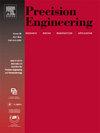基于XY挠性平台的交叉耦合动力学建模与阻尼抑制
IF 3.5
2区 工程技术
Q2 ENGINEERING, MANUFACTURING
Precision Engineering-Journal of the International Societies for Precision Engineering and Nanotechnology
Pub Date : 2025-01-20
DOI:10.1016/j.precisioneng.2025.01.012
引用次数: 0
摘要
柔性机构在微纳运动中有着广泛的应用。多轴运动中的交叉耦合是精密运动系统误差的重要来源。虽然柔性纳米定位平台的静态和动态特性已经得到了广泛的研究,但其运动交叉耦合的统一参数表达式仍然缺乏,阻尼对交叉耦合的影响也没有得到深入的分析。在本文中,我们进一步建立了柔性机构的力-位移关系模型,并提出了基于梁约束模型(BCM)的精密运动平台动态交叉耦合的分析框架。我们预测了交叉耦合效应,并分析量化了几何上的交叉耦合误差。将该模型应用于柔性纳米定位平台的静态和动态交叉耦合分析,考察了阻尼对减少交叉耦合的影响。实验结果表明,采用被动阻尼后,低频动态交叉耦合比降低了6.52%,谐振频率动态交叉耦合比降低了10.37%。非线性动态交叉耦合模型有效地预测了交叉耦合行为和阻尼的影响,为交叉耦合的阻尼特性预测提供了一种更简单、更清晰的方法。该模型可以集成到误差补偿和抑制阻尼诱导交叉耦合的控制系统中,为柔性机构的阻尼控制提供了新的见解。本文章由计算机程序翻译,如有差异,请以英文原文为准。
Dynamic modeling and damping-induced suppression of cross-coupling in an XY flexure-based stage
Compliant mechanisms are widely utilized in micro-nano motion applications. Cross-coupling in multi-axis motion is a significant source of errors in precision motion systems. Although the static and dynamic properties of flexure-based nanopositioning stages have been extensively studied, their unified parametric expressions for motion cross-coupling are still lacking, and the impact of damping on cross-coupling has not been thoroughly analyzed. In this paper, we further model the force–displacement relationship of compliant mechanisms and present an analytical framework for the dynamic cross-coupling of a precision motion stage based on the Beam Constraint Model (BCM). We predict the cross-coupling effect and analytically quantify cross-coupling errors in geometry. As a case study, this model is applied to the static and dynamic cross-coupling analysis of a flexure-based nanopositioning stage, examining the effective of damping on cross-coupling reduction. Experimental results show that the dynamic cross-coupling ratio decreased by 6.52% at low frequencies and 10.37% at the resonant frequency when the stage was equipped with passive damping. The nonlinear dynamic cross-coupling model effectively predicts cross-coupling behavior and the impact of damping, offering a simpler and clearer approach for forecasting the damping characteristics of cross-coupling. This model can be integrated into control systems for error compensation and the rejection of damping-induced cross-coupling, providing new insights into damping control in compliant mechanisms.
求助全文
通过发布文献求助,成功后即可免费获取论文全文。
去求助
来源期刊
CiteScore
7.40
自引率
5.60%
发文量
177
审稿时长
46 days
期刊介绍:
Precision Engineering - Journal of the International Societies for Precision Engineering and Nanotechnology is devoted to the multidisciplinary study and practice of high accuracy engineering, metrology, and manufacturing. The journal takes an integrated approach to all subjects related to research, design, manufacture, performance validation, and application of high precision machines, instruments, and components, including fundamental and applied research and development in manufacturing processes, fabrication technology, and advanced measurement science. The scope includes precision-engineered systems and supporting metrology over the full range of length scales, from atom-based nanotechnology and advanced lithographic technology to large-scale systems, including optical and radio telescopes and macrometrology.

 求助内容:
求助内容: 应助结果提醒方式:
应助结果提醒方式:


